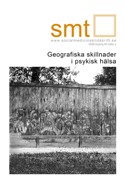Abstract
Geografiska analyser kompliceras av att den mentala ohälsan är svår att läges- och tidsbestämma. Komplikationerna ligger bl.a. i att orsakerna kan finnas långt tillbaka i de berörda personernas liv samt av flyttningar. För att förstå den mentala ohälsans geografiska sammanhang behöver man därför mera flexibla metoder och tillgång till mycket detaljerade data. Det finns idag geografiska tekniker och perspektiv som ännu bara har använts i mycket ringa omfattning för att analysera mental hälsa och ohälsa. Bland dessa finns både kvantitativa och icke-kvantitativa tillvägagångssätt. Med geografiska informationssystem kan man åstadkomma mycket sofistikerade epidemiologiska analyser, men GIS förutsätter tillgång till högupplösta data, även om individer. Andra möjligheter är att analysera vardagssituationer och hur dessa kan innebära mentala påfrestningar. Vissa geografer använder även geografiska begrepp för att nå insikter i mentalt störda personers föreställningsvärldar och omvärldsrelationer. Näraliggande forskning handlar om känslomässiga förhållanden till platser samt om hur kroppsliga sjukdomar och funktionshinder kan inverka på den mentala hälsan genom att hindra de drabbades från att besöka platser som har personlig betydelse.While health geography, alias medical geography, has become an established, albeit small, sub-discipline in geography, mental health has remained a rather marginal topic. Nevertheless, through the last couple of decades ambitions have been rising and a variety of approaches are emerging. Geographical analyses of mental (ill) health are complicated by difficulties in determining its spatial and temporal occurrence – which is a prerequisite for a true geographical analysis. Whereas the definition of mental health status per se is not a geographical question, the spatial determination definitely is. Thus, geographical analyses may be hampered by disputable definitions and diagnoses. Further, complications may arise from the lapse of time and migration, sometimes expressed with the complementary notions of drift and breed. Do certain places breed ill health or do they attract individuals who are already ill or predisposed for certain disorders? Like early ‘medical’ geography, conventional approaches to the geography of mental health have attempted either to clarify the epidemiology of the disorders or to analyse the interplay between health care on the one hand and the need or demand for it on the other. In recent years, a new ‘wave’ is characterized by a diversity of theories, methods and research issues. The aims are not only to understand the specific circumstances in particular places but also to unveil and dissect structural, and potentially harmful, processes. One budding strand of research attempts to capture everyday situations and their impact on mental well-being. Another line emanates from the notion of therapeutic places and landscapes – places which seem to have a salubrious or healing effect on troubled minds. Among these contemporary and emerging approaches some colleagues use geographical, spatial, concepts to gain insight in and explore the life-worlds of individuals, for example mentally disturbed persons. Also, various life crises may induce affected people to re-negotiate their relations with emotionally significant places. Thus, understanding the geographical context and potential causal circumstances of mental ill health, requires more flexible methods as well as high-resolution data. Today, academic geography applies hi-tech tools, such as Geographical Information Systems (GIS) as well as intellectual, non-quantitative, instruments. Neither has, by far, been sufficiently exploited in mental health geography. Keywords: health geography, medical geography, mental health
Författare som medverkar i Socialmedicinsk tidskrift accepterar att deras verk publiceras under licensen Creative Commons Attribution-NonCommercial 3.0 Unported. Denna licens tillåter att en tredje person delar ut författarens arbete (kopierar, distribuerar och sänder verket) och skapar bearbetningar av det under förutsättning att: författaren/na och/eller licensgivaren anges på ett korrekt sätt, verket inte används i kommersiellt syfte samt om verket återanvänds eller distribueras måste information tydligt anges om upphovsrättsvillkoren som gäller för verket.
Författare behåller upphovsrätt för deras arbete men garanterar samtidigt publiceringsrättigheter för första publicering och all publicering via Internet till Socialmedicinsk tidskrift. Vidare kräver Socialmedicinsk tidskrift att författaren överför samtliga upphovsrättigheter för kommersiell användning av verket till utgivaren (Socialmedicinsk tidskrift). Inkomster från kommersiell försäljning används för att kunna fortsätta att publicera smt både i tryckt format och online utan publiceringsavgifter.
